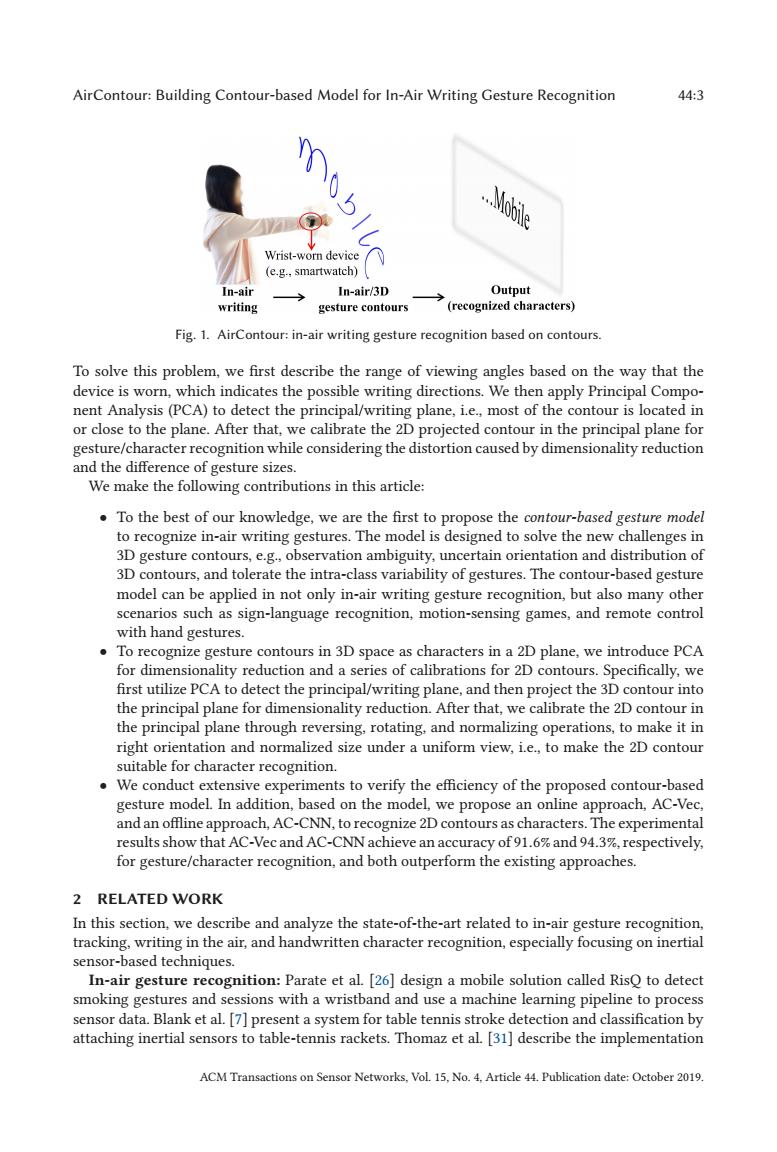正在加载图片...

AirContour:Building Contour-based Model for In-Air Writing Gesture Recognition 44:3 .Modote Wrist-worn device (e.g.,smartwatch) In-air In-air/3D Output writing gesture contours (recognized characters) Fig.1.AirContour:in-air writing gesture recognition based on contours. To solve this problem,we first describe the range of viewing angles based on the way that the device is worn,which indicates the possible writing directions.We then apply Principal Compo- nent Analysis(PCA)to detect the principal/writing plane,i.e.,most of the contour is located in or close to the plane.After that,we calibrate the 2D projected contour in the principal plane for gesture/character recognition while considering the distortion caused by dimensionality reduction and the difference of gesture sizes. We make the following contributions in this article: To the best of our knowledge,we are the first to propose the contour-based gesture model to recognize in-air writing gestures.The model is designed to solve the new challenges in 3D gesture contours,e.g.,observation ambiguity,uncertain orientation and distribution of 3D contours,and tolerate the intra-class variability of gestures.The contour-based gesture model can be applied in not only in-air writing gesture recognition,but also many other scenarios such as sign-language recognition,motion-sensing games,and remote control with hand gestures. To recognize gesture contours in 3D space as characters in a 2D plane,we introduce PCA for dimensionality reduction and a series of calibrations for 2D contours.Specifically,we first utilize PCA to detect the principal/writing plane,and then project the 3D contour into the principal plane for dimensionality reduction.After that,we calibrate the 2D contour in the principal plane through reversing,rotating,and normalizing operations,to make it in right orientation and normalized size under a uniform view,i.e.,to make the 2D contour suitable for character recognition. We conduct extensive experiments to verify the efficiency of the proposed contour-based gesture model.In addition,based on the model,we propose an online approach,AC-Vec, and an offline approach,AC-CNN,to recognize 2D contours as characters.The experimental results show that AC-Vec and AC-CNN achieve an accuracy of 91.6%and 94.3%,respectively, for gesture/character recognition,and both outperform the existing approaches. 2 RELATED WORK In this section,we describe and analyze the state-of-the-art related to in-air gesture recognition, tracking,writing in the air,and handwritten character recognition,especially focusing on inertial sensor-based techniques. In-air gesture recognition:Parate et al.[26]design a mobile solution called RisQ to detect smoking gestures and sessions with a wristband and use a machine learning pipeline to process sensor data.Blank et al.[7]present a system for table tennis stroke detection and classification by attaching inertial sensors to table-tennis rackets.Thomaz et al.[31]describe the implementation ACM Transactions on Sensor Networks,Vol.15,No.4.Article 44.Publication date:October 2019.AirContour: Building Contour-based Model for In-Air Writing Gesture Recognition 44:3 Fig. 1. AirContour: in-air writing gesture recognition based on contours. To solve this problem, we first describe the range of viewing angles based on the way that the device is worn, which indicates the possible writing directions. We then apply Principal Component Analysis (PCA) to detect the principal/writing plane, i.e., most of the contour is located in or close to the plane. After that, we calibrate the 2D projected contour in the principal plane for gesture/character recognition while considering the distortion caused by dimensionality reduction and the difference of gesture sizes. We make the following contributions in this article: • To the best of our knowledge, we are the first to propose the contour-based gesture model to recognize in-air writing gestures. The model is designed to solve the new challenges in 3D gesture contours, e.g., observation ambiguity, uncertain orientation and distribution of 3D contours, and tolerate the intra-class variability of gestures. The contour-based gesture model can be applied in not only in-air writing gesture recognition, but also many other scenarios such as sign-language recognition, motion-sensing games, and remote control with hand gestures. • To recognize gesture contours in 3D space as characters in a 2D plane, we introduce PCA for dimensionality reduction and a series of calibrations for 2D contours. Specifically, we first utilize PCA to detect the principal/writing plane, and then project the 3D contour into the principal plane for dimensionality reduction. After that, we calibrate the 2D contour in the principal plane through reversing, rotating, and normalizing operations, to make it in right orientation and normalized size under a uniform view, i.e., to make the 2D contour suitable for character recognition. • We conduct extensive experiments to verify the efficiency of the proposed contour-based gesture model. In addition, based on the model, we propose an online approach, AC-Vec, and an offline approach, AC-CNN, to recognize 2D contours as characters. The experimental results show that AC-Vec and AC-CNN achieve an accuracy of 91.6% and 94.3%, respectively, for gesture/character recognition, and both outperform the existing approaches. 2 RELATED WORK In this section, we describe and analyze the state-of-the-art related to in-air gesture recognition, tracking, writing in the air, and handwritten character recognition, especially focusing on inertial sensor-based techniques. In-air gesture recognition: Parate et al. [26] design a mobile solution called RisQ to detect smoking gestures and sessions with a wristband and use a machine learning pipeline to process sensor data. Blank et al. [7] present a system for table tennis stroke detection and classification by attaching inertial sensors to table-tennis rackets. Thomaz et al. [31] describe the implementation ACM Transactions on Sensor Networks, Vol. 15, No. 4, Article 44. Publication date: October 2019